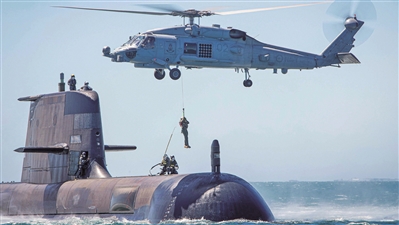By Liu Liang
刘 亮

Lately, the news about the US and the UK helping Australia build nuclear submarines has not only seriously disgruntled France whose submarine contract with Australia was called off as a result, but also triggered heated discussions and arguments in the international community. At present, the trilateral cooperation on the research and manufacturing of nuclear submarines is in a very early stage and the technical and other details are not finalized yet. Although nuclear submarine has more advantages than conventional ones, it is just a good choice on the surface for Australia because once it enters the substantive stage, more difficulties will pop up and likely put a heavy burden on the country.
近日,美英两国与澳大利亚合作建造核潜艇的消息,不仅引发被澳大利亚取消潜艇合同的法国强烈不满,也引起国际社会的讨论和争议。目前,美英澳3国合作研制核潜艇一事仅处于意向阶段,技术、合作等具体细节仍需进一步敲定。相比常规动力潜艇,核潜艇确具优势。但对于澳大利亚来说,这只是个看上去不错的选择,一旦项目进入实质性阶段,各种问题将逐步暴露,很可能成为其负担。
On the one hand, the project itself is problem-riddled. Australia originally planned to work with France to build 12 Barracuda-class conventional submarines to replace its six aged Collins-class submarines, and the first one is projected by foreign media to start serving in the early 2030s. Now that Canberra canceled its contract with Paris and turned to Washington and London for nuclear submarine cooperation, it won’t be able to get its first new submarine until 2040, at which time its youngest Collins-class submarine would have served nearly 40 years. The Australian Navy is seeking to rent submarines to fill in the gap before its new nuclear submarines can be commissioned.
一方面,核潜艇项目本身问题重重。澳大利亚原计划与法国合作建造12艘梭鱼级常规潜艇,替代6艘老旧的柯林斯级潜艇。据外媒估计,首艘潜艇将于本世纪30年代早些时候服役。然而,澳大利亚取消与法国的合同,转而与美英两国合作建造核潜艇,将使其获得新潜艇的时间延后至2040年。届时,柯林斯级潜艇中最后建成的6号艇也将服役近40年。澳大利亚海军正在寻求租用潜艇,以填补核潜艇服役前的空窗期。
Australia is inexperienced in submarine development and hasn’t fully grasped the technologies of conventional ones yet, so there is a big question mark over whether it can digest the complicated nuclear submarine technology even with America and Britain’s help. The Collins-class submarine is developed with Sweden’s Västergötland-class littoral submarine as the prototype. Australian Navy reckoned that since the prototype is an excellent littoral submarine, the Collins-class, a simple three-fold magnification of it, must be an excellent ocean-going submarine. This unscientific and even childish thought has led to constant problems with the Collins-class and a high maintenance cost.
澳大利亚在潜艇发展方面经验不足,常规潜艇相关技术尚未完全掌握,即便有美英两国帮助,能否“消化”复杂的核潜艇技术是个问题。柯林斯级潜艇以瑞典西约特兰级近海潜艇为基础研制。澳大利亚海军认为,西约特兰级作为一型优秀的近海潜艇,以其为基础简单放大近3倍的柯林斯级潜艇必然是一型优秀远洋潜艇。这种不科学、简单化甚至有些幼稚的想法导致柯林斯级潜艇问题频出,维护成本居高不下。
On the other hand, nuclear submarines will be a heavy burden on Australia. Although Canberra has worked out an ambitious plan, it may not be able to bear the huge cost of design, manufacture and use. The nuclear submarine is a money guzzler. Even the less expensive one – the Virginia-class attack submarine of the US Navy – once cost USD 2.7 billion each and later rose to USD 3 billion, while the Columbia-class ballistic missile nuclear-powered submarine that’s under construction now costs as much as USD 7 billion. Even if Australia’s nuclear submarine isn’t as large as its American and British counterparts, the redesign and re-manufacturing alone mean an astronomical figure.
另一方面,核潜艇将成为澳大利亚的巨大包袱。尽管澳大利亚制订了野心勃勃的核潜艇计划,但未必承担得起庞大的设计、建造和使用成本。核潜艇本身就是一只“吞金兽”,核潜艇中较为便宜的美海军弗吉尼亚级攻击型核潜艇单价也达27亿美元,随后上涨至30亿美元,而美国正在建造的哥伦比亚级弹道导弹核潜艇造价达70亿美元。即使澳大利亚核潜艇在吨位方面未必像美英核潜艇那样大,但重新设计制造核反应堆,也会造成成本飙升。
At the same time, nuclear reactor, a vital part of the nuclear submarine, has to be operated and maintained by a large number of professionals, which Australia doesn’t have because it has no nuclear power station. Of course, it can still rely on the US and the UK to cultivate nuclear professionals for it and then establish its own talent cultivation system and talent pool step by step, but that will be a long and expensive process.
同时,核反应堆作为核潜艇的核心组成部分,需要大量专业人员操作维护,而澳大利亚没有核电站,缺乏相关人才和人才培养能力。依托美英两国培养相关人才,再建立自身人才培养体制和人才梯队,耗时耗费良多。
Moreover, Australia’s so-called nuclear submarine will probably use a nuclear reactor that, like American and British ones, uses highly enriched uranium (HEU) as fuel and relies on fuel supply from the two countries. The US Navy’s HEU for nuclear-powered submarines and aircraft carriers is expected to deplete in 2060, so there is no telling whether Australia’s HEU demand can be met. It’s worth noting that HEU can be used to make nuclear weapons, which is an important reason why the trilateral cooperation in nuclear submarine development is so widely criticized.
此外,澳大利亚所谓的核潜艇,核反应堆很可能效仿美英两国以高浓缩铀为原料,并依赖后者供应。美海军用于核潜艇和核动力航母的高浓缩铀预计2060年耗尽,能否保障澳大利亚的需求是个未知数。值得注意的是,高浓缩铀可用于制造核武器,这也是美英澳3国合作发展核潜艇备受批评的重要原因。
Analysts said that as the Australian economy depends on resource export, the country has neither the industrial capability to design and manufacture a nuclear submarine, nor the professionals to operate it, nor the financial strength to afford such a money-guzzling undertaking. Developing nuclear submarines will squeeze the capital needed to upgrade other weapons and equipment, and put a huge economic burden on the country, causing a series of economic and political chain effects.
对此,有评论认为,澳大利亚经济发展基本依赖资源出口,既缺乏设计、建造核潜艇的工业能力和操作核潜艇的相关人才,也无力承担高昂成本。其发展核潜艇不仅会压减其他武器装备更新换代所需资金,还将背上沉重经济负担,造成经济、政治等方面一系列连锁反应。













